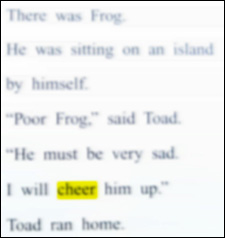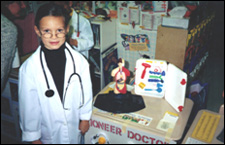
FROM THE BEGINNING…
Vision is our most precious possession. From the moment of birth, thousands of bits of information pass through the brain. Learning actually commences from that first breath of air. Seeing is a passive phenomenon during the first few years of life. Infants look at big grown-up faces, watch big TV's, and play with oversized toys. However, when a child reaches school age, their visual system becomes an active, integral part of their education.
ALL ON THEIR OWN
By themselves, they must learn to control the focus and fixation of their eyes to concentrate on smaller, more precise objects. They must learn to discern the foreground from the background. They must learn how to fuse the two different images from each eye into one unified image. They must also learn to master the skill of eye-hand coordination.
NO ROOM FOR ERROR
Most children achieve these basic fundamental skills. However, if the visual and ocular motor stimuli sent to the brain are wrong then the child is not going to develope properly and the parent will begin to see less then desired results. It is, therefore, imperative that any visual condition be detected and corrected at an early age.

“I CAN'T SEE…"
The problem is kids don't realize that they're having eye problems. They think the whole world sees and perceives things just as they do. Often, they give us signs of visual distress that we overlook and attribute to other things, such a poor behavior, or lack of interest.
WHAT COULD BE WRONG?
A lot of the more common visual anomalies often go undetected for extended periods of time. Many of them may not even be picked up in visual screenings. Tha'ts why it is so important to have your child have a pediatric eye examination at least by age three.
MYOPIA (nearsighted)
This is when a child's distance vision is blurry. Perceptually, the child's world is no longer infinite but now has definite borders of distinction and uncertainty. Common signs of nearsightedness are headaches, squinting, and getting close to everything. A squinting child can usually pass any vision screening. That's why it's imperative not to rely on screening results but to have a complete pediatric eye examination. The state of Illinois was in agreement as they passed a law requiring all children to have an eye exam before entering kindergarten. We have the technology and skill to be able to get reliable results even if your child is too young or too shy to respond.

Hard to learn when the print looks like this

Good vision gives your special one the chance to follow their dreams
HYPEROPIA (farsighted)
Literally, with hyperopia, a child can see very clearly only at distance. However, because of their young age, most children can overcome their farsightedness and still read, although with a tremendous amount of strain. Red, watery eyes; pinpoint pupils, and poor reading skills are often associated with hyperopia. Unless the condition is moderately severe, it usually goes undetected in screenings. This can be the root of poor school performance.
ASTIGMATISM
Astigmatism occurs when the eye is oval shaped and the light focuses in two points instead of one. This can cause blurred vision at both distance and near, headaches, poor reading and writing skills. All these symptoms can be a detriment to learning in school.
HETEROPHORIA (muscle imbalance)
In this condition one of the 12 eye muscles is not properly aligned and prevents the eyes from working smoothly together, causing stress and premature fatigue. This can severely affect their performance in school. All effort is exerted toward keeping the eyes properly aligned so as single vision will persist. Misalignment of the eyes can cause double vision.
ACCOMMODATIVE INSUFFICIENCY (Inability to focus close up)
This condition is caused by weak inner muscles that control the lens inside the eye. These often can be strengthened with vision therapy. Bifocals are often prescribed. Again, the child may have poor reading and writing skills and a generally negative
ACCOMMODATIVE INFACILITY (Focus inflexibility)
This condition also deals with the inner muscles that control the lens inside the eye. The child lacks the ability to change focus smoothly and accurately from far to near and vice versa. The focusing system is usually in a spastic state from excess stress. Everyone has experienced a spastic muscle at some point; a cramp while running is an example.

FRUSTRATION
Any of the aforementioned conditions along with many others can make close work extremely uncomfortable. Any kind of visual stress can lower reading scores and distort visual perception. Comprehension is lowered because the child's energy is diverted toward the maintenance of clear, single vision rather than the understanding of the materials' contents. Moreover, kids are often scolded and constantly reminded that their work is not up to potential. This can create a tremendous amount of frustration for the child. In some cases, it can lower self-esteem.
POOR TV RECEPTION
To give you an idea of what it is like for a child that has visual problems, just try sitting watching a movie with poor, snowy reception and see how much eyestrain is produced. You will find yourself not wanting to watch your favorite movie because it's uncomfortable. Or try reading a book while you are rapidly and constantly blinking your eyes. Your comprehension and reading skills will decline and you'll avoid any further near work.
THE WARNING SIGNS…
- having headaches
- squinting
- having red eyes
- excess tearing
- frequent rubbing or blinking of the eyes
- developing styes
- tilting the head
- using poor posture when reading
- sitting too close to the TV
- having poor reading and/or writing skills
- reversing letters
- moving with general awkwardness
- daydreaming
- having poor eye-hand coordination
If you see your child struggling with any of the above, or school work that seems to be below potential, schedule a Pediatric Eye Examination. It would be a shame if something so easily corrected was overlooked. Exams can usually be submitted to your medical insurance.

